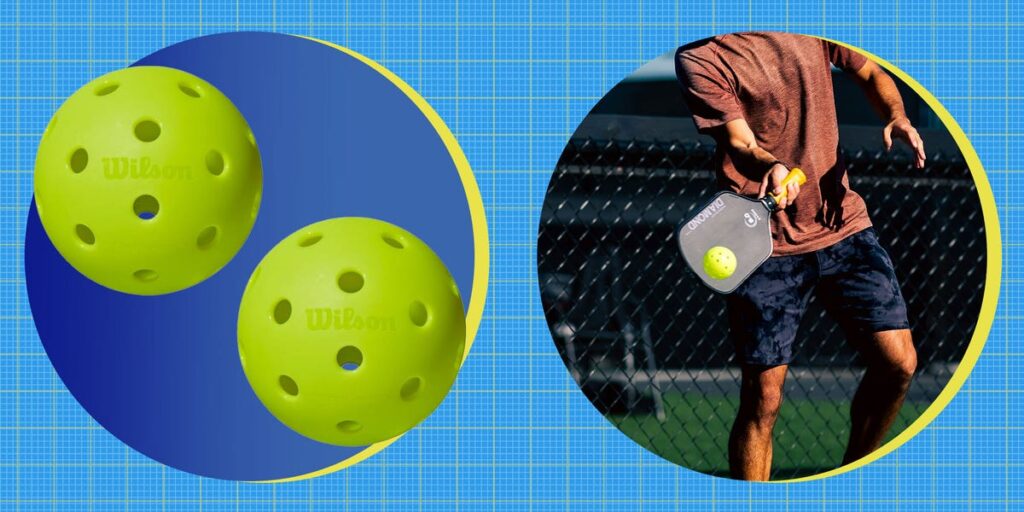It’s hard to tell the difference from one pickleball to another, but small details like the size of the holes in a ball and how the ball is molded can greatly impact your game. The science of what makes a good pickleball ball is crucial to knowing what type of pickleball you should be looking for. A lot of it also depends on your skill level and how frequently you play, but the best pickleball balls can be widely used by a variety of players.
What to Consider
Materials
When looking for pickleball balls to buy you want to first check the material its made of. There are three basic plastics that pickleball balls are constructed with: polypropylene, polyethylene, and ABS plastic. Polypropylene is typically the softest and offers good bounce for indoor play. Polyethylene is like a hybrid that can be good for general all-around play. ABS plastic is the hardest and offer high durability and is good for outdoor play.
Firmness
A ball should be firm and resistant to denting. If you can easily press your finger into the ball and create an indentation, then it’s likely the ball will be prone to dead spots and not bounce properly.
Holes
Next, you want to make sure the holes in the ball are evenly dispersed and clean cut. The holes are what deliver balance, so if anything is off the chances of the ball wavering or “waffling” in the air are increased. Some balls are cut with more holes than others, and other balls are cut with bigger holes than what you might normally see. These minor details can ultimately dictate how fast a ball plays—more numerous, tighter hole cuts usually result in a faster ball.
Rotational vs. Injection Molded
If you are playing at a competitive level, it’s worth checking the molding process of the ball. A rotational molded pickleball is made by the plastic being put into a gyrating process and forming the ball with no seam. These balls are usually faster and and last longer, yet they are more expensive due to the production process. Injection molded involves a process where the ball is formed in two parts and then molded together. An injection molded ball is bouncier and cheaper, yet they are prone to splitting over time as that ball gets more wear and tear.
Indoors Vs. Outdoors
Pickleball is played just as much indoor as it is outdoor. Indoor surfaces are generally smoother and more polished, like a gymnasium floor, while outdoor are rougher and harder.
Indoor Pickleball Balls
Generally speaking, an indoor pickleball ball is often softer and lighter because of the fact there won’t be any wind impacting it’s travel. The ball also sometimes has bigger holes to ensure a higher bounce since indoor floors (usually wood) aren’t as strong as outdoor courts (typically concrete).
Outdoor Pickleball Balls
On the flip side, an outdoor pickleball ball is going to typically be a tad bit heavier and made with stronger materials to combat weather elements like wind and humidity. An outdoor ball will be made with more abrasive-resistant materials to better handle scuffs and impacts.
How We Selected
We consulted with Men’s Health‘s editors and writers on the best pickleball balls in 2025. Experts and editors who play frequently put a number pickleball balls to the test and evaluated their performance, durability, and value. The Men’s Health editors and writers have been playing their fair share of pickleball over the past few years, and so each ball has been carefully chosen to reflect different environments and personal preferences of all types of picklers.
We also considered top-reviewed pickleball balls that had high customer ratings on e-commerce websites we trust. In total, we tested over 15 different pickleball balls and found 8 we recommend.
” data-next-head/>
John Thompson is the Senior Gear and Commerce Editor at Men’s Health, where he covers fashion, grooming, gear, and technology. He was previously the Style & Gear Editor at BroBible.com, and a commerce writer for TheManual.com. His interests include attending concerts, spending time outside, and following his favorite baseball team, the Kansas City Royals.
Ryan Brower is the Senior Gear and Commerce Editor at Men’s Health, where he tests the best products in outdoor gear and tech. Baseball, surfing, and camping occupied most of his time growing up.
He also trained in martial arts for 12 years and holds a third degree black belt. He has written about the outdoors for nearly two decades and was previously the Managing Editor, Content Performance at Gear Patrol. He is also a Certified Beer Server and previously covered the craft beer industry. Ryan currently lives on the water in New Jersey with his wife and their dog.
Watch Next
Advertisement – Continue Reading Below
Advertisement – Continue Reading Below
Advertisement – Continue Reading Below
Read the full article here



